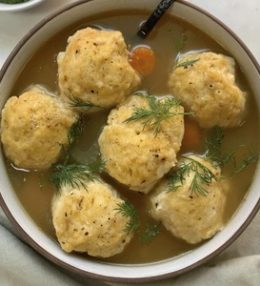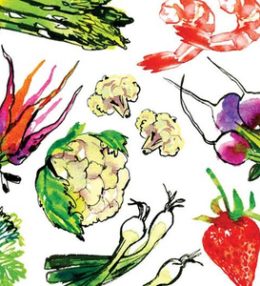
Traditionally, we pour the bubbly on New Year’s Eve, but what about the menu? Of course, that depends on where you live. In different cultures, certain foods are believed to bring good luck in the year ahead. These New Year’s food traditions from around the world have unique meanings and are well worth considering putting on your menu as you set your intentions for the year ahead.
Cara Cormack
Whether it’s black-eyed peas as part of a New Year’s Day brunch or cabbage on New Year’s Eve, adding these good luck foods to your party plans are a delicious way to say see-ya to the old year and hello to a lucky new year.
Pork
Ham is often a holiday centerpiece, but pork is specifically thought to bring good luck on New Year’s Day. So why is pork a New Year’s food tradition?
First, it has to do with the way pigs behave differently than other animals. According to some theorists, while chickens and turkeys scratch backward, a pig buries his snout into the ground and moves forward—in the same direction you want to head in the new year. Another reason is logistics: Pigs are traditionally slaughtered in late fall, which makes pork an ideal choice to set aside for celebrating the new year. Finally, pork (and cabbage) eaten on New Year’s is a German and Eastern European tradition brought to America by early settlers.
Start your new year off right with these Barbecue Pork Sandwiches With Crunchy Coleslaw.
Cabbage
Right alongside the pork is often sauerkraut or some form of cabbage. This tradition also hails from Germany and Eastern Europe and is rooted in simple logistics: A late fall harvest coupled with a six-to-eight-week fermenting process means that sauerkraut is just about ready when New Year’s rolls around.
Cabbage on New Year’s is also steeped in symbolism—the strands of cabbage in sauerkraut or coleslaw can symbolize long life, while cabbage can also represent money. Try your luck with this recipe for a Japanese Cabbage Pancake.
Black-Eyed Peas
Eating black-eyed peas on New Year’s Day is a time-honored tradition. Black-eyed peas are actually a kind of bean, not to be confused with green peas (or the hip hop band). There are a few different reasons they’re associated with luck on New Year’s Day.
One theory anchors the tradition in the Civil War, when Union soldiers raided the Confederate army’s food supply, leaving behind only this bean. Another theory is anchored in African American history, where newly-freed enslaved people celebrated the January 1863 Emancipation Proclamation with dishes made of black-eyed peas—one of the few foods available to enslaved people. But other theories date the legume’s lucky reputation back to Ancient Egypt, suggesting that eating the pea—a vegetable readily available to even the poorest enslaved people—was a way to show humility to the gods. Help increase your chances for a prosperous new year with this recipe for Black-Eyed Pea Ribollita.
Greens
Black-eyed peas naturally go hand-in-hand with greens as a great combination, but greens themselves are known to be lucky for New Year’s. So why do people eat collard greens on the New Year?
It’s all about the color green, which symbolizes money and prosperity. Also, according to some traditions rooted in the South, greens can be hung by the door to ward off any evil spirits that may come your way. It can’t hurt, right? Here is a collard greens with bacon recipe that’s simple, delicious, and lucky.
Rice
Rice is a staple of New Year’s celebrations in Asia—and in the South, where it’s paired with red beans for Hoppin’ John, which is served on New Year’s Eve and New Year’s Day to bring prosperity and luck. It’s associated with prosperity and good luck, and in India, it’s believed it can take away bad omens. You could try a simple red beans and rice recipe, or serve it up Asian style with a chicken congee.
Cornbread
One thing that many of the lucky New Year’s foods have in common? (Besides being delicious, of course!) They represent—or even look like—things that represent wealth and good fortune. Cornbread’s golden hue and often round shape (especially when made in a cast-iron skillet) represents gold—an obvious representation of good fortune in the new year. Corn spoon bread includes both cornmeal and fresh or frozen corn kernels for extra corn goodness.
Lentils
Lentils are a legume that is often served in Italian households, and their legend is rooted in prosperity: The round legumes look like coins. For New Year’s Eve, nutritious lentils are traditionally eaten after midnight, along with pork and sausages.
Need more lentils in your life? Consider adding this Carrot and Red Lentil Soup to your New Year’s Eve arsenal.
New Year’s Pretzel
Thank the Germans for this sweet finish to the old year and start of the new. A sweet pretzel (often frosted or sugared) is broken and shared amongst your guests at some point between midnight and the morning to bring goodness into the next year. You can see a recipe for a New Year’s pretzel here, or enjoy our simple, savory focaccia version below,
Fish
Fish is another common dish on plates around the world on New Year’s—especially in cultures close to water. For example, in Scandinavian countries, herring was considered a harbinger of good fortune, especially as the silver-scaled fish called to mind valuable money. Herring, heavily traded, was also essential to the country’s prosperity.
Eating herring was a way to hope for a good catch in the months to come because herring had unpredictable migration patterns, and a good year didn’t necessarily indicate the next year would be as successful.
Today, herring still symbolizes good fortune, making it an excellent option for a New Year’s appetizer. Likewise, pickled herring makes a tasty crostini topper on any crostini party platter. Not a herring fan? Sardines are a member of the same fish family, and are also considered lucky. Try these Smoked Sardine Toasts With Lemon Mayo and Fennel Salad and test this theory for yourself.
Noodles
In China, Japan, and many other Asian countries, it’s customary to serve and eat noodles on New Year’s Day. Their length symbolizes longevity—so make sure not to break or shorten the noodles during the cooking process.
Serve soba noodles, udon, sesame stir-fried noodles, or try this delicious recipe for Spicy Coconut Noodles.
Grapes and Other Fruit
In Filipino culture, New Year’s Eve is traditionally celebrated with 12 types of fruit. They choose 12 specifically to symbolize each month. Filipinos tend to prefer round fruits, but mangoes and watermelon also make the cut. In Mexico, grapes are eaten at midnight to symbolize the year ahead. In China and other Asian countries, oranges are prized for their round shape and gold-like hue as a representation of good fortune.
Throughout the world, pomegranates, a symbol of fertility and birth, are eaten at the new year. A jewel-toned slice of Pomegranate-Almond Toast is an easy and delicious way to start the New Year on the right foot.
Dumplings
Dumplings are a pan-culture holiday favorite, with every country having their own take on it. Dumplings are a big part of Lunar New Year celebrations, as their shape resembles money bags. You’re encouraged to eat plenty of dumplings, to help bring you wealth and good fortune in the New Year. (P.S. These turkey and scallion dumplings make good use of any leftover holiday turkey you have lurking in your freezer.)
Vasilopita Cake
When isn’t cake a fantastic celebration option? Many cultures have specific New Year’s cakes. For example, the Greeks enjoy a cake called Vasilopita, also known as king pie or basil pie. The cake is made only for New Year’s and eaten on New Year’s Day (see a Vasilopita from 2017 in the picture). This Greek New Year’s cake is sweet, bready, and topped with almonds. Traditionally, the cake is baked with a coin or trinket inside, and the person who gets the treasure-filled slice is supposed to have good luck for the year ahead.
Frequently Asked Questions
-
What dessert do you eat on New Year’s Day?
A number of countries have special New Year’s dessert suggestions, such as the Vasilopita above, Denmark’s kransekage (a stack of ring-shaped almond cakes), the Netherlands’ doughnut-like olliebollen, or Germany’s sweetened New Year’s pretzel. In China, it’s all about the nian gao, a sweet glutinous rice cake.
-
Are you supposed to eat black eyed peas on New Year’s Eve or New Year’s Day?
Black-eyed peas have been linked to luck and good fortune for New Year’s since around the Civil War era. Serve them with cornbread and greens for a delicious triple threat of good luck.
-
What does corn bread mean on New Year’s Day?
Cornbread’s circular shape and golden hue mimics a gold coin, so it represents wealth and prosperity in the New Year.
Traditionally, we pour the bubbly on New Year’s Eve, but what about the menu? Of course, that depends on where you live. In different cultures, certain foods are believed to bring good luck in the year ahead. These New Year’s food traditions from around the world have unique meanings and are well worth considering putting on your menu as you set your intentions for the year ahead. Cara Cormack Whether it’s black-eyed peas as part of a New Year’s Day brunch or cabbage on New Year’s Eve, adding these good luck foods to your party plans are a delicious way to say see-ya to the old year and hello to a lucky new year. Pork Romulo Yanes Ham is often a holiday centerpiece, but pork is specifically thought to bring good luck on New Year’s Day. So why is pork a New Year’s food tradition? First, it has to do with the way pigs behave differently than other animals. According to some theorists, while chickens and turkeys scratch backward, a pig buries his snout into the ground and moves forward—in the same direction you want to head in the new year. Another reason is logistics: Pigs are traditionally slaughtered in late fall, which makes pork an ideal choice to set aside for celebrating the new year. Finally, pork (and cabbage) eaten on New Year’s is a German and Eastern European tradition brought to America by early settlers. Start your new year off right with these Barbecue Pork Sandwiches With Crunchy Coleslaw. Cabbage Jennifer Causey Right alongside the pork is often sauerkraut or some form of cabbage. This tradition also hails from Germany and Eastern Europe and is rooted in simple logistics: A late fall harvest coupled with a six-to-eight-week fermenting process means that sauerkraut is just about ready when New Year’s rolls around. Cabbage on New Year’s is also steeped in symbolism—the strands of cabbage in sauerkraut or coleslaw can symbolize long life, while cabbage can also represent money. Try your luck with this recipe for a Japanese Cabbage Pancake. Black-Eyed Peas Caitlin Bensel Eating black-eyed peas on New Year’s Day is a time-honored tradition. Black-eyed peas are actually a kind of bean, not to be confused with green peas (or the hip hop band). There are a few different reasons they’re associated with luck on New Year’s Day. One theory anchors the tradition in the Civil War, when Union soldiers raided the Confederate army’s food supply, leaving behind only this bean. Another theory is anchored in African American history, where newly-freed enslaved people celebrated the January 1863 Emancipation Proclamation with dishes made of black-eyed peas—one of the few foods available to enslaved people. But other theories date the legume’s lucky reputation back to Ancient Egypt, suggesting that eating the pea—a vegetable readily available to even the poorest enslaved people—was a way to show humility to the gods. Help increase your chances for a prosperous new year with this recipe for Black-Eyed Pea Ribollita. Greens Jonny Valiant Black-eyed peas naturally go hand-in-hand with greens as a great combination, but greens themselves are known to be lucky for New Year’s. So why do people eat collard greens on the New Year? It’s all about the color green, which symbolizes money and prosperity. Also, according to some traditions rooted in the South, greens can be hung by the door to ward off any evil spirits that may come your way. It can’t hurt, right? Here is a collard greens with bacon recipe that’s simple, delicious, and lucky. Rice Jennifer Causey Rice is a staple of New Year’s celebrations in Asia—and in the South, where it’s paired with red beans for Hoppin’ John, which is served on New Year’s Eve and New Year’s Day to bring prosperity and luck. It’s associated with prosperity and good luck, and in India, it’s believed it can take away bad omens. You could try a simple red beans and rice recipe, or serve it up Asian style with a chicken congee. Cornbread Lynne Mitchell/Getty Images One thing that many of the lucky New Year’s foods have in common? (Besides being delicious, of course!) They represent—or even look like—things that represent wealth and good fortune. Cornbread’s golden hue and often round shape (especially when made in a cast-iron skillet) represents gold—an obvious representation of good fortune in the new year. Corn spoon bread includes both cornmeal and fresh or frozen corn kernels for extra corn goodness. Lentils Greg DuPree Lentils are a legume that is often served in Italian households, and their legend is rooted in prosperity: The round legumes look like coins. For New Year’s Eve, nutritious lentils are traditionally eaten after midnight, along with pork and sausages. Need more lentils in your life? Consider adding this Carrot and Red Lentil Soup to your New Year’s Eve arsenal. New Year’s Pretzel Caitlin Bensel Thank the Germans for this sweet finish to the old year and start of the new. A sweet pretzel (often frosted or sugared) is broken and shared amongst your guests at some point between midnight and the morning to bring goodness into the next year. You can see a recipe for a New Year’s pretzel here, or enjoy our simple, savory focaccia version below, Fish Greg DuPree Fish is another common dish on plates around the world on New Year’s—especially in cultures close to water. For example, in Scandinavian countries, herring was considered a harbinger of good fortune, especially as the silver-scaled fish called to mind valuable money. Herring, heavily traded, was also essential to the country’s prosperity. Eating herring was a way to hope for a good catch in the months to come because herring had unpredictable migration patterns, and a good year didn’t necessarily indicate the next year would be as successful. Today, herring still symbolizes good fortune, making it an excellent option for a New Year’s appetizer. Likewise, pickled herring makes a tasty crostini topper on any crostini party platter. Not a herring fan? Sardines are a member of the same fish family, and are also considered lucky. Try these Smoked Sardine Toasts With Lemon Mayo and Fennel Salad and test this theory for yourself. Noodles Beatriz da Costa In China, Japan, and many other Asian countries, it’s customary to serve and eat noodles on New Year’s Day. Their length symbolizes longevity—so make sure not to break or shorten the noodles during the cooking process. Serve soba noodles, udon, sesame stir-fried noodles, or try this delicious recipe for Spicy Coconut Noodles. Grapes and Other Fruit Caitlin Bensel In Filipino culture, New Year’s Eve is traditionally celebrated with 12 types of fruit. They choose 12 specifically to symbolize each month. Filipinos tend to prefer round fruits, but mangoes and watermelon also make the cut. In Mexico, grapes are eaten at midnight to symbolize the year ahead. In China and other Asian countries, oranges are prized for their round shape and gold-like hue as a representation of good fortune. Throughout the world, pomegranates, a symbol of fertility and birth, are eaten at the new year. A jewel-toned slice of Pomegranate-Almond Toast is an easy and delicious way to start the New Year on the right foot. Dumplings Brie Passano Dumplings are a pan-culture holiday favorite, with every country having their own take on it. Dumplings are a big part of Lunar New Year celebrations, as their shape resembles money bags. You’re encouraged to eat plenty of dumplings, to help bring you wealth and good fortune in the New Year. (P.S. These turkey and scallion dumplings make good use of any leftover holiday turkey you have lurking in your freezer.) Vasilopita Cake tolisma/Getty Images When isn’t cake a fantastic celebration option? Many cultures have specific New Year’s cakes. For example, the Greeks enjoy a cake called Vasilopita, also known as king pie or basil pie. The cake is made only for New Year’s and eaten on New Year’s Day (see a Vasilopita from 2017 in the picture). This Greek New Year’s cake is sweet, bready, and topped with almonds. Traditionally, the cake is baked with a coin or trinket inside, and the person who gets the treasure-filled slice is supposed to have good luck for the year ahead. Frequently Asked Questions What dessert do you eat on New Year’s Day? A number of countries have special New Year’s dessert suggestions, such as the Vasilopita above, Denmark’s kransekage (a stack of ring-shaped almond cakes), the Netherlands’ doughnut-like olliebollen, or Germany’s sweetened New Year’s pretzel. In China, it’s all about the nian gao, a sweet glutinous rice cake. Are you supposed to eat black eyed peas on New Year’s Eve or New Year’s Day? Black-eyed peas have been linked to luck and good fortune for New Year’s since around the Civil War era. Serve them with cornbread and greens for a delicious triple threat of good luck. What does corn bread mean on New Year’s Day? Cornbread’s circular shape and golden hue mimics a gold coin, so it represents wealth and prosperity in the New Year.
Good Luck Cupcake









